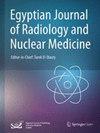T2 mapping post acute myocardial infarction: a novel technique in assessing myocardial edema
IF 0.5
Q4 RADIOLOGY, NUCLEAR MEDICINE & MEDICAL IMAGING
Egyptian Journal of Radiology and Nuclear Medicine
Pub Date : 2024-09-02
DOI:10.1186/s43055-024-01341-9
引用次数: 0
Abstract
Cardiovascular magnetic resonance (CMR) is considered the gold standard imaging modality for assessing myocardial infarction lesions, offering precise myocardial tissue characterization. Elevated transverse relaxation time (T2) serves as a specific indicator of increased myocardial water content, thus becoming a valuable index for myocardial edema. However, conventional T2-weighted CMR sequence exhibits several limitations, primarily providing qualitative information. In contrast, recently developed quantitative T2 mapping techniques overcome these limitations, enabling a more reliable assessment of myocardial edema. These techniques offer the advantage of diagnosing and monitoring myocardial injury without the necessity of contrast agents. Our study aims to add to a growing literature demonstrating the efficacy of quantitative T2 mapping technique to detect and quantify regions of myocardial edema post-myocardial infarction. Native T1 and T2 mapping accurately identified myocardial edema in all patients enrolled in the study. Notably, native T1 and T2 values exhibited a significant elevation in the infarcted myocardium compared to the remote myocardium (for T1: 1295.50 ± 87.65 vs. 1074.95 ± 92.86 ms, respectively; and for T2: 74.63 ± 6.51 vs. 52.53 ± 6.26 ms, respectively; p < 0.0001 for both). Microvascular obstruction was observed in 12 out of 20 patients, affecting one or more myocardial segments within the infarct areas. Among this subgroup, regions with a microvascular obstruction within the infarct zone displayed lower T1 and T2 values compared to areas of infarction without microvascular obstruction (for T1: 1115.05 ± 64.70 vs. 1295.50 ± 87.65 ms, respectively; and for T2: 53.65 ± 3.56 vs. 74.63 ± 6.51 ms, respectively; p < 0.0001 for both). Additionally, we provided reference values for myocardial T1 and T2 specific to our facility’s 1.5 Tesla CMR system, applicable to both infarct and remote myocardium. Parametric T1 and T2 mapping techniques can detect and quantify myocardial edema resulting from myocardial infarction. The presence of microvascular obstruction that results from revascularization injury affects both T1 and T2 values. This information can be used and has broad clinical implications for diagnosis and guiding or monitoring the treatment of myocardial infarction.急性心肌梗死后的 T2 映射:评估心肌水肿的新技术
心血管磁共振(CMR)被认为是评估心肌梗死病变的金标准成像模式,可提供精确的心肌组织特征。横向弛豫时间(T2)的升高是心肌含水量增加的具体指标,因此成为心肌水肿的重要指标。然而,传统的 T2 加权 CMR 序列有一些局限性,主要提供定性信息。相比之下,最近开发的定量 T2 映射技术克服了这些局限性,能对心肌水肿进行更可靠的评估。这些技术的优势在于无需造影剂即可诊断和监测心肌损伤。越来越多的文献表明,定量 T2 映像技术能有效检测和量化心肌梗死后的心肌水肿区域,我们的研究旨在为这些文献添砖加瓦。本机 T1 和 T2 图谱能准确识别所有参与研究的患者的心肌水肿。值得注意的是,与远端心肌相比,梗死心肌的原生 T1 和 T2 值明显升高(T1:分别为 1295.50 ± 87.65 vs. 1074.95 ± 92.86 ms;T2:分别为 74.63 ± 6.51 vs. 52.53 ± 6.26 ms;两者的 p <0.0001)。20 名患者中有 12 人出现微血管阻塞,影响到梗死区域内的一个或多个心肌节段。在这一亚组中,梗死区内有微血管阻塞的区域与无微血管阻塞的梗死区域相比,T1 和 T2 值更低(T1:分别为 1115.05 ± 64.70 vs. 1295.50 ± 87.65 ms;T2:分别为 53.65 ± 3.56 vs. 74.63 ± 6.51 ms;两者的 P < 0.0001)。此外,我们还提供了针对本机构 1.5 特斯拉 CMR 系统的心肌 T1 和 T2 参考值,适用于梗死和远端心肌。参数 T1 和 T2 映射技术可检测和量化心肌梗塞导致的心肌水肿。血管再通损伤导致的微血管阻塞会影响 T1 和 T2 值。这些信息可用于诊断和指导或监测心肌梗塞的治疗,并具有广泛的临床意义。
本文章由计算机程序翻译,如有差异,请以英文原文为准。
求助全文
约1分钟内获得全文
求助全文
来源期刊

Egyptian Journal of Radiology and Nuclear Medicine
Medicine-Radiology, Nuclear Medicine and Imaging
CiteScore
1.70
自引率
10.00%
发文量
233
审稿时长
27 weeks
 求助内容:
求助内容: 应助结果提醒方式:
应助结果提醒方式:


